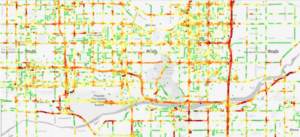Airlib explain how they are using data to improve air quality for everyone who spends time in traffic.
Air quality sensors have been used on high end cars for more than 30 years to improve their in-cabin air quality by switching to air recirculation when traffic pollution is high.
These sensors generate more than 2 trillion datapoints each day, the greatest reservoir of air quality data in the world.
Car connectivity now makes it possible to exploit this data to improve air quality for everyone who spends time in traffic. Airlib recently completed a study in a major city to demonstrate how it can be done.
Data was collected for about a year from city cars fitted with automotive air quality sensors. More than 10,000 trips were used to create high-resolution air quality maps.

A recirculation flap control algorithm was designed based on map values ahead of cars in traffic. The smart open/close flap algorithm was then applied to 50 city trips. The calculated in-cabin pollution was compared to the same 50 trips with no smart flap control. The results showed over 40% average reduction in passenger exposure to pollution peaks. This is a compelling result which is expected to have a positive impact on cabin health and comfort.
As the volume of data collected increases, the predictive value of the maps will grow, and even more air quality gains can be expected.
It is estimated that major cities can be mapped with air quality data collected from less than one car in a thousand. Approximately 1,000 cars would be sufficient in London or Paris. A number that is within reach as soon as one of the major car manufacturers gets involved in the data collection chain. Indeed, every year more than 5 million new air quality sensors are mounted on new connected cars.
This solution is therefore scalable worldwide with no hardware cost and because it is a commercially appealing avenue for monetizing automotive data, it is likely to become a standard car-tech feature in the near future. It could for example get integrated into Android automotive or become an optional Android automotive app.
The new air quality dataset will also be usable for non-automotive applications for joggers, bikers or general urban residents interested in air quality. Functions like ‘cleaner route recommendations’ or personal pollution exposure trackers could be implemented via dedicated apps . The data would also be a valuable complement for air quality professionals and government bodies.
Automotive air quality data is therefore an eminently actionable opportunity with potentially high benefits in terms of public health. A moderate software deployment effort with high societal payoff.
Photo supplied by www.airlib.co












